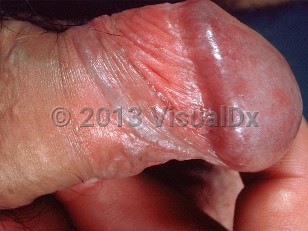Bowenoid papulosis
See also in: AnogenitalAlerts and Notices
Important News & Links
Synopsis

Bowenoid papulosis (BP) is a clinical variant of a low-grade squamous cell carcinoma in situ (SCCIS) caused by the human papillomavirus (HPV), usually subtypes 16 and 18, although other subtypes may be responsible. Smoking, early sexual initiation, multiple sexual partners, uncircumcised male sexual partners, and immunosuppression are contributory factors.
There is an equal male-to-female ratio. Lesions are usually asymptomatic, but may be pruritic, and occur primarily in the genital and perianal region.
BP has a variable course, with a frequent potential for spontaneous regression as well as persistence and recurrence. A postsurgical excision recurrence rate in around one-fifth of cases has also been documented.
The risk of progression to invasive SCC in immunocompetent patients is estimated at 2.6%. In immunocompromised patients, the risk of invasive malignancy, including cervical neoplasia, may be higher; one-half of HIV-infected patients with anogenital warts have SCCIS on histology.
BP typically occurs in young sexually active adults. However, cases have been reported in children. Although evidence of pediatric BP does not confirm sexual abuse, the possibility of sexual transmission should be thoroughly investigated.
In 2015, the International Society for the Study of Vulvovaginal Diseases (ISSVD) recommended the term high-grade squamous intraepithelial lesion (HSIL) to encompass all histopathologic diagnoses of vulvar precancer, and does not specifically delineate the clinical entity of BP. Many dermatology textbooks continue to include BP given its distinctive clinical appearance.
There is an equal male-to-female ratio. Lesions are usually asymptomatic, but may be pruritic, and occur primarily in the genital and perianal region.
BP has a variable course, with a frequent potential for spontaneous regression as well as persistence and recurrence. A postsurgical excision recurrence rate in around one-fifth of cases has also been documented.
The risk of progression to invasive SCC in immunocompetent patients is estimated at 2.6%. In immunocompromised patients, the risk of invasive malignancy, including cervical neoplasia, may be higher; one-half of HIV-infected patients with anogenital warts have SCCIS on histology.
BP typically occurs in young sexually active adults. However, cases have been reported in children. Although evidence of pediatric BP does not confirm sexual abuse, the possibility of sexual transmission should be thoroughly investigated.
In 2015, the International Society for the Study of Vulvovaginal Diseases (ISSVD) recommended the term high-grade squamous intraepithelial lesion (HSIL) to encompass all histopathologic diagnoses of vulvar precancer, and does not specifically delineate the clinical entity of BP. Many dermatology textbooks continue to include BP given its distinctive clinical appearance.
Codes
ICD10CM:
D04.9 – Carcinoma in situ of skin, unspecified
SNOMEDCT:
402913004 – Bowenoid papulosis
D04.9 – Carcinoma in situ of skin, unspecified
SNOMEDCT:
402913004 – Bowenoid papulosis
Look For
Subscription Required
Diagnostic Pearls
Subscription Required
Differential Diagnosis & Pitfalls

To perform a comparison, select diagnoses from the classic differential
Subscription Required
Best Tests
Subscription Required
Management Pearls
Subscription Required
Therapy
Subscription Required
References
Subscription Required
Last Reviewed:08/11/2019
Last Updated:02/18/2020
Last Updated:02/18/2020
Bowenoid papulosis
See also in: Anogenital
